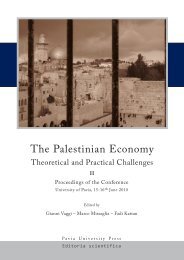Musica che affronta il silenzio - Scritti su Toru Takemitsu - Pavia ...
Musica che affronta il silenzio - Scritti su Toru Takemitsu - Pavia ...
Musica che affronta il silenzio - Scritti su Toru Takemitsu - Pavia ...
Create successful ePaper yourself
Turn your PDF publications into a flip-book with our unique Google optimized e-Paper software.
142<br />
Mit<strong>su</strong>ko Ono<br />
taught that Japan was the <strong>su</strong>preme country, and did not acknowledge the value of other<br />
countries’ cultures. When the war ended with Japan’s defeat, the boy Takemit<strong>su</strong>, who was<br />
then fourteen years old, is said to have felt that the war was foolish. I <strong>su</strong>ppose that<br />
Takemit<strong>su</strong> might have had the desire to open the windows of Japanese culture, in order to<br />
avoid a situation in which information was shut out, as during the war, and to perform this<br />
task of vent<strong>il</strong>ation thoroughly. He observed the reality of Japan, understanding the situation<br />
overseas wh<strong>il</strong>e maintaining friendships with creative individuals, for example musicians,<br />
novelists and painters who express something by means of their art. He did not live abroad<br />
and communicate from the outside, but lived in Japan, as though he accepted it as his fate to<br />
be born in that nation. And I think that he set a high value on the chance to communicate<br />
with various people, crossing the boundaries between artists and scholars, transcending<br />
national borders, and believing in the expression of man’s intellect and feelings through a<br />
wonderful common property of human beings: music.<br />
Whatever score material st<strong>il</strong>l remains in Tru Takemit<strong>su</strong>’s studio w<strong>il</strong>l soon be donated<br />
by his fam<strong>il</strong>y to the Documentation Centre for Modern Japanese Music in Tokyo.<br />
This foundation had preserved a lot of material relating to Japanese composers. However<br />
they have announced that all the material w<strong>il</strong>l be transferred to “Meiji Gakuin” University,<br />
because they have management difficulties this <strong>su</strong>mmer.<br />
Since the beginning of the 21 st century, there has been a growing tendency to see the<br />
history of the 20 th century from an objective point of view. From now on, research based on<br />
this historical view w<strong>il</strong>l advance too. To conclude my speech, I would like to introduce the<br />
concept that Takemit<strong>su</strong> was preparing for the Tokyo Opera City, which he passed away without<br />
seeing completed. It was: Prayer, Hope, Peace. Thank you very much.<br />
Bibliography<br />
Nomura, Noriko (2007), Production Note: Teshigahara Hiroshi Eiga Kotohajime, Studio<br />
246, Tokyo.<br />
Ozawa, Seiji – Takemit<strong>su</strong>, Tru (1984), Ongaku, Shinchshosa, Tokyo.<br />
Takemit<strong>su</strong>, Asaka (2006), Talks about Tru Takemit<strong>su</strong>, Shgakukan, Tokyo.<br />
Takemit<strong>su</strong>, Tru (1995), Confronting S<strong>il</strong>ence: Selected Writings, Fallen Leaf Press,<br />
Berkeley.<br />
––––– (2003), Complete Takemit<strong>su</strong> Edition, Shgakukan, Tokyo, vol. 3.<br />
Takemit<strong>su</strong>, Tru – Ozawa, Seiji (1981), Ongaku, Ningen, Nihon ni t<strong>su</strong>ite: Ongaku no<br />
Niwa, Shinchsha, Tokyo.

















